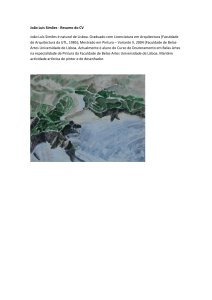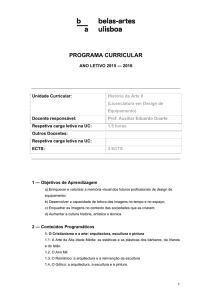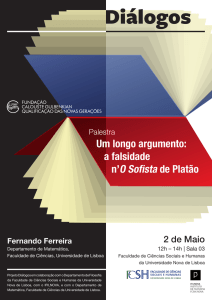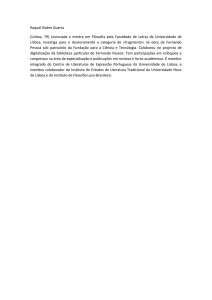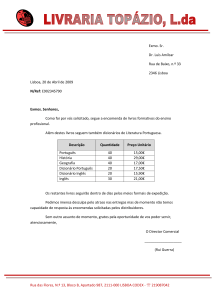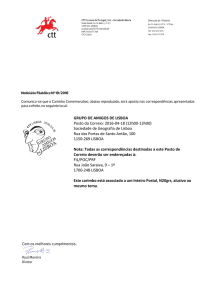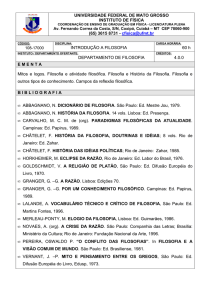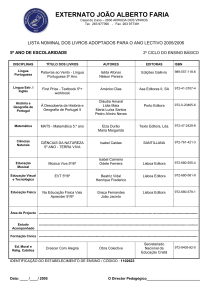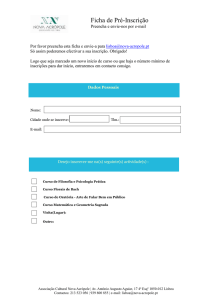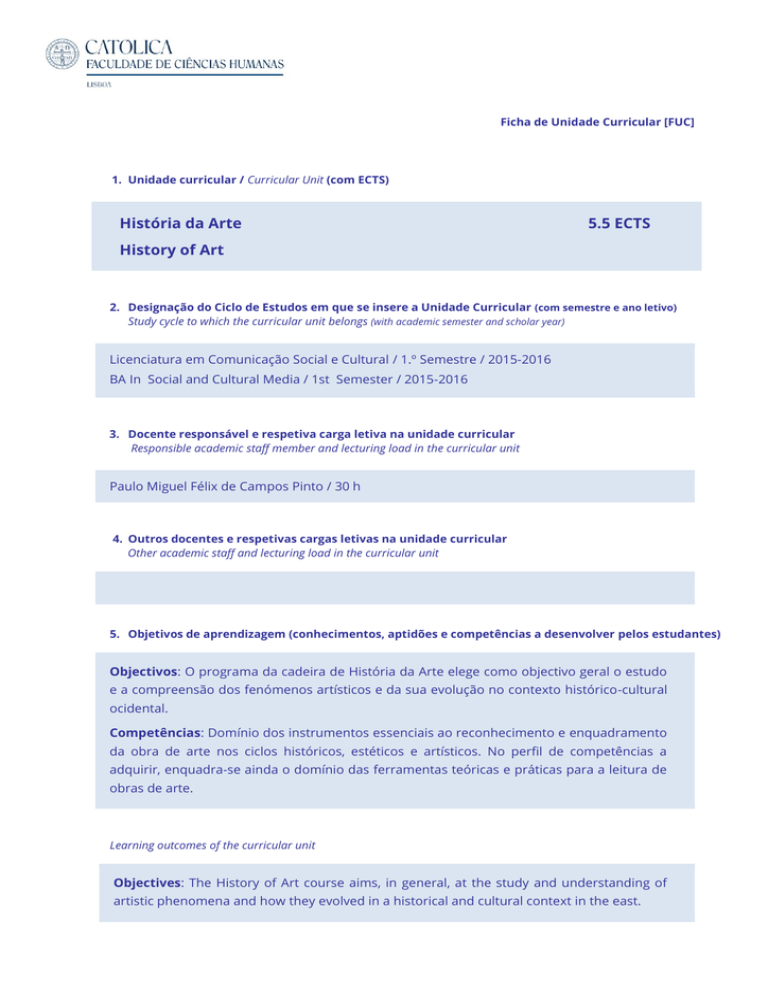
Ficha de Unidade Curricular [FUC]
1. Unidade curricular / Curricular Unit (com ECTS)
História da Arte
5.5 ECTS
History of Art
2. Designação do Ciclo de Estudos em que se insere a Unidade Curricular (com semestre e ano letivo)
Study cycle to which the curricular unit belongs (with academic semester and scholar year)
Licenciatura em Comunicação Social e Cultural / 1.º Semestre / 2015-2016
BA In Social and Cultural Media / 1st Semester / 2015-2016
3. Docente responsável e respetiva carga letiva na unidade curricular
Responsible academic staff member and lecturing load in the curricular unit
Paulo Miguel Félix de Campos Pinto / 30 h
4. Outros docentes e respetivas cargas letivas na unidade curricular
Other academic staff and lecturing load in the curricular unit
5. Objetivos de aprendizagem (conhecimentos, aptidões e competências a desenvolver pelos estudantes)
Objectivos: O programa da cadeira de História da Arte elege como objectivo geral o estudo
e a compreensão dos fenómenos artísticos e da sua evolução no contexto histórico-cultural
ocidental.
Competências: Domínio dos instrumentos essenciais ao reconhecimento e enquadramento
da obra de arte nos ciclos históricos, estéticos e artísticos. No perfil de competências a
adquirir, enquadra-se ainda o domínio das ferramentas teóricas e práticas para a leitura de
obras de arte.
Learning outcomes of the curricular unit
Objectives: The History of Art course aims, in general, at the study and understanding of
artistic phenomena and how they evolved in a historical and cultural context in the east.
Skills: Mastering the essential tools in order to recognize and situate a work of art in
historical, aesthetic and artistic cycles. The skills to be acquired also include the mastering of
theoretical and practical tools to interpret the works of art.
6. Conteúdos programáticos
1. A ARTE - OBJECTO, NATUREZA E MÉTODO: Os significados da obra de Arte; A História da
Arte – definições, objectivos e metodologias; Arte e Cultura; Arte e Sociedade.
2. DAS PRIMEIRAS EXPERIÊNCIAS ÀS GRANDES SISTEMATIZAÇÕES: O Mundo Pré-Clássico –
Egipto e Mesopotâmia.
3. A ARTE CLÁSSICA: A Arte Grega; A Arte Romana.
4. A IDADE MÉDIA: O Românico; O Gótico.
5. RENASCIMENTO E MANEIRISMO: Introdução histórica e cultural – Humanismo e
Classicismo; O Renascimento em Itália – Arquitectura, Pintura e Escultura; O
Renascimento nórdico; O Alto Renascimento; O Maneirismo.
6. O BARROCO: O conceito e a cultura Barroca. O espírito da Contra- Reforma; A
Arquitectura do barroco – Itália, França; A Pintura Barroca – Itália, França, Países
Baixos, Espanha e Holanda.
7. O ROCOCÓ: A Arquitectura – França, Alemanha e Áustria. As Igrejas de Peregrinação; A
Escultura e a decoração; A Pintura Rococó – França e Veneza. A Fête Galante e a Veduta.
8. O NEOCLASSICISMO: Arte e Teoria - Racionalismo e Neoclassicismo - Winckelmann e o
Belo Ideal.; A Arquitectura - o 2º Estilo Luís XV, o Paladianismo Internacional – Inglaterra
e EUA; A Pintura – De David a Ingres; A Escultura.
9. O ROMANTISMO (1815-1848): A Arquitectura – Revivalismo e Eclectismo: Inglaterra,
França, Alemanha; A Pintura – Inglaterra, França, Alemanha. A Escultura.
10. OS ALVORES DA MODERNIDADE (1850-1890): As construções do Ferro e a Arquitectura
Racionalista – França, Inglaterra e EUA; A Pintura – Naturalismo e Realismo;
Impressionismo e Neo-Impressionismo. A Fotografia; O advento da modernidade – Van
Gogh, Gauguin e Cézanne.
11. ARTE NOVA E SIMBOLISMO (1893-1902): Arquitectura – Espanha, Bélgica e França,
Inglaterra, Áustria e Alemanha; A Pintura – Simbolismo, os Pré-Rafaelitas, Arte Nova e
Ilustração, os Nabis.
12. O SÉCULO XX - A PRIMEIRA METADE (1905-1950): As Vanguardas - Fauvismo, Cubismo,
Expressionismo, Abstracção; A Arquitectura no limiar do movimento moderno; O
período entre Guerras - Dada, Surrealismo, Arte e o Poder.
13. A IIª GUERRA MUNDIAL E O SEGUNDO PÓS-GUERRA (1945-1970): As Artes Plásticas na
Europa; O "Nascimento da Arte Americana; A arquitectura e a revisão do Movimento
Moderno.
14. PÓS-MODERNO E CRISE DO FIM DE SÉCULO (1970-2000): As artes plásticas depois do
ocaso das vanguardas; Correntes da arquitectura contemporânea.
Nota: Em cada semestre serão dados apenas alguns pontos do programa, a indicar no
início do ano lectivo.
Syllabus
1. ART - OBJECTIVES, NATURE AND METHOD: The meanings of a work of Art; The History
of Art – definitions, objectives and methodologies; Art and Culture; Art and Society.
2. FROM THE FIRST EXPERIENCES TO THE GREAT SYSTEMATIZATIONS: The Pre-Classical
World – Egypt and Mesopotamia.
3. THE CLASSICAL ART: The Greek Art; The Roman Art.
4. THE MIDDLE AGES: The Romanic; The Gothic
5. THE RENAISSANCE AND MANNERISM: Historical and cultural introduction – Humanism
and Classicism; The Renaissance in Italy-Architecture, Painting and Sculpture;The
Nordic Renaissance; The High Renaissance; Mannerism.
6. THE BARROQUE: The Baroque concept and culture. The spirit of the Protestant
Reform; The architecture of the Baroque - Italy, France. The Painting of the Baroque –
Italy, France, the Netherlands, Spain and Holland.
7. ROCOCO: The Architecture – France, Germany and Austria. The Pilgrimage churches;
Sculpture and decoration; Rococo painting – France and Venice. The Fête Galante and
Veduta.
8. NEOCLASSICISM: Art and Theory - Rationalism and Neoclassicism - Winckelmann and
Ideal Beauty; Architecture the 2nd Louis XV style; Palladian Architecture worldwide –
England and USA; Painting – From David to Ingres; Sculpture.
9. ROMANTICISM (1815-1848): Architecture – Revival and Eclecticism: England, France,
Germany; Painting – England, France, Germany. Sculpture.
10. THE DAWM OF MODERN TIMES (1850-1890): The constructions of the Iron Period and
Rationalist Architecture – France, England and USA; Painting – Naturalism and Realism;
Impressionism and Neo-Impressionism. Photography; The Dawn of modernity – Van
Gogh, Gauguin and Cézanne.
11. ART NOUVEAU AND SYMBOLISM (1893-1902): Architecture– Spain, Belgium and
France, England, Austria and Germany; Painting – Symbolism, the Pre-Raphaelites, Art
Nouveau and Illustration, Les Nabis.
12. THE 20TH CENTURY – THE FIRST HALF (1905-1950): The Vanguards - Fauvism, Cubism,
Expressionism, Abstraction; Architecture at the threshold of the modern movement;
The period between the Wars - Dada, Surrealism, Art and Power.
13. THE SECOND WORLD WAR AND THE SECOND POST WAR (1945-1970): Plastic Arts in
Europe; The ‘Birth’ of American Art; Architecture and the revision of the Modern
Movement.
14. MODERN AND THE END-OF-THE-CENTURY CRISIS (1970-2000): Plastic arts after the
decline of the vanguards; Movements of contemporary architecture.
Note: In each semester only some topics of the programme will be focused, this will be
indicated at the beginning of the academic year.
7. Metodologia de ensino (avaliação incluída)
Leccionação: Aulas teórico-práticas:
a)
Método expositivo, com recurso a audiovisuais;
b)
Método participativo, com recurso à apresentação, pelos alunos, de exercícios
complementares, ao longo do semestre, com quatro objectivos: aquisição de
competências a partir da aplicação de conhecimentos; identificação de fontes de
informação sobre arte e eventos culturais, através da prática de pesquisa de fontes
de informação; estímulo ao estudo permanente, através de exercícios de
demonstração de conhecimentos adquiridos; desenvolvimento da capacidade de
observação, através de exercícios de leitura de imagens.
Avaliação: O sistema de avaliação é contínuo e apoia-se nos seguintes instrumentos:
Teste escrito (45%)
Trabalho individual a ser apresentado e defendido em sala de aula. Tema a definir
com o docente (45%)
Participação nas aulas: assiduidade, pontualidade, qualidade das intervenções e
exercícios complementares (10%).
Teaching methodologies (including evaluation)
Teaching: Theoretical/practical classes:
a)
Lectures using audiovisuals to complement them;
b)
Participation of students, by means of presentations and complementary exercises
throughout the semester, four objectives: the acquisition of competences by
applying the knowledge gained; identification of sources of information on art and
cultural events through research; the stimulation for permanent study through
exercises which reveal the knowledge acquired; the development of the capacity to
observe through exercises in analyzing images.
Assessment: Assessment is continuous and based on the following:
Written test (45%);
Individual work to be presented and defended in class. A theme to be defined with
the teacher (45%);
Participation in class: attendance, punctuality, quality of the participation and
complementary exercises (10%).
8. Bibliografia principal
Main bibliography
Bibliografia Geral / General Bibliography
AAVV, Histoire de l’Art Flammarion, vols. 1 a 4, Paris: Flammarion, 1995-7.
AAVV, J. Pijoan (dir.). História da Arte, 10 vols., Lisboa: Publicações Alfa, 1988.
AAVV. Helen Ronan (coord. Ed.), A Nova História da Arte de Janson, Lisboa: Fundação
Caloust Gulbenkian, 2010.
AAVV, Martin Kemp (Ed.), The Oxford History of Western Art, Oxford: Oxford University
Press, 2000.
BAZIN, Germain, História da Arte, Lisboa: Livraria Bertrand, 1974 (reed. 1976, 1992).
CHÂTELET, Albert e GROSLIER, Bernard Ph., História da Arte Larousse, 3 vols., Lisboa:
Civilização.
FRANÇA, José Augusto, História da Arte Ocidental 1780 – 1880, Lisboa: Livros Horizonte,
1987.
PAIS DA SILVA, Jorge Henrique, Páginas da História da Arte, 2 vols., Lisboa: Ed. Estampa,
1997.
THUILLIER, Jacques, Histoire de l’Art, Paris: Flammarion, 2002.
Leitura e análise de obras de arte / Reading and analysis of works of art
CALABRESE, Omar, Como se lê uma Obra de Arte, Lisboa: Edições 70, 1998.
HUYGHE, René, O Sentido e Destino da Arte, 2 vols., Lisboa: Edições 70, 1986.
LUCIE-SMITH, Eduard, Diccionário de Termos de Arte, Lisboa: Dom Quixote, sd..
PARSONS, Michael J., Compreender a Arte, Lisboa: Editorial Presença, sd..
VENTURI, Lionello, Para compreender a Pintura, Lisboa: Editorial Estudos Cor, 1968.
Estudos / Studies
Chantal Orgogoza, L’Art égyptien, colec. Grammaire des Styles, Paris: Flammarion, 1996.
John Summerson, A Linguagem Clássica da Arquitectura, São Paulo: Martins Fontes, 1982.
John Boarman, Greek Art, Londres, Thames and Hudson, 1973.
Susan Woodford, Grécia e Roma, Rio de Janeiro: Zahar Editores, 1983.
Georges Duby, História Artística da Europa – A Idade Média, 2 vols. Lisboa: Quetzal
Editores, 1998.
Georges Duby, São Bernardo e a Arte Cisterciense, Porto: Edições Asa, 1997.
Henri Focillon, Arte do Ocidente – a idade média românica e gótica, Lisboa: Estampa, 1980.
Rolf Toman, Achim Bednorz, O Gótico – Arquitectura, Escultura, Pintura, Koln: Konemann,
2000.
Rolf Toman, A Arte da Renascença Italiana - Arquitectura, Escultura, Pintura, Koln:
Konemann, 2000.
Richard Turner, La Rennaicense à Florence, Paris: Flammarion, 1997.
Jean- François Boisset, La Rennaicense Italienne, Paris: Flammarion, 1996.
André Chastel, LÁrt Italien, Paris: Flammarion, 1995.
Anthony Blunt, Art and Architecture in France 1500 to 1700, Londres: Penguin, 1988.
Erwin Panofsky, Renascimento e Renascimentos na Arte Ocidental, Lisboa: Editorial
Presença, 1981.
Giulio C. Argan, L’Age Barroque, Geneve: Albert Skira, 1989.
Victor L. Tapié, Barroco e Classicismo, 2 vols. Lisboa: Presença, 1988.
Rudolf Wittkower, Art and Architecture in Italy 1600 to 1750, Londres: Penguin, 1986.
J. Miguel Morán e F. Checa Cremades, El Barroco, Madrid: Istmo, 1982.
Germain Bazin, Barroco and Rococo, Londres: Thames and Hudson, 1987.
Albert Boime, Art in the Age of Revolution 1750 – 1800, Chicago e Londres: U. Chicago,
1987.
Pierre Cabane, L’Art du XVIIIe Siècle, Paris: Somogy, 1987.
J. Summerson, The Architecture of Eighteenth Century, Londres: Thames & Hudson, 1986.
Michael Levey, Rococó to Revolution, Londres: Thames & Hudson, 1980.
Jean Starobinsky, L’Invention de la Liberté, Geneve: Skira Flammarion, 1987.
Philippe Minguet, Estética del Rococó, Madrid: Catedra, 1992.
Rosario A La anteguedad como futuro; Estudio sobre la estetica del neoclassicismo europeo,
Madrid: Visor, 1990.
Francis Claudon, Enciclopédia do Romantismo, Lisboa: Verbo, 1986.
B. Champigneulle, Arte Nova, Lisboa: Verbo, 1984.
Nota: A bibliografia de apoio, mais específica, será indicada no decurso das aulas
Note: Further bibliography, more specific, will be referred in class.

